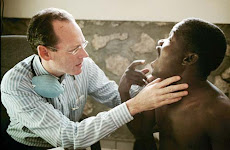I have made diagrams of these which I will scan tomorrow with Katharine in the library!
CELL MEDIATED IMMUNITY (uses T cells to lyse the cell)
Step 1: Begins with an antigen (virus) enters a body cell.
Step 2: The cell becomes infected with the virus. The cell uses the virus's machinery to make copies of itself.
Step 3: During the infection some of the viral proteins (antigens) are broken down by the cell and attached to class 1 MHC marker proteins.
Step 4: Through exocytosis Class 1 MHC marker proteins present themselves on the cell surface.
Step 5: Cytotoxic T cells participate in this phase. It has T cell receptors that are SPECIFIC for the displayed antigen. The T cell binds to the MHC marker protein.
Step 6: Binding activates the T cell and the T cell is able to divide and make numerous copies of itself with the same marker.
Step 7: Effector Phase: Binding during the effector phase causes the T cell to release PERFORIN - little tiny weapon that breaks open the cell membrane and causes the cell membrane to break (lysis) leading to cell death.
HUMORAL IMMUNITY - uses antibodies to inactivate the antigen
Step 1: Begins with the ACTIVATION phase when the cell of the immune system (macrophage) engulfs and antigen.
Step 2: Inside the cell the vesicle with the antigen (phagosome) fuses with the lysosome which contains digestive enzymes. This enzyme breaks antigen into particles. The fragments combine with class 2 MHC marker proteins. The MHC marker protein displays itself on the macrophage outer cell membrane.
Step 3: Helper T cells have specific binding sites for Class II MHC marker proteins and bind to protein complex.
Step 4: Activation occurs and because of the binding of the Helper T cell and MHC protein clones of the T cell are made that have specific binding sites for the antigen of interest.
Step 5: Effector phase begins with a B CELL. The B cell has an IgM receptor or Antibody specific for the antigen. The antigen fits into the antibody.
Step 6: When the antigen is bond to the antibody the B cell engulfs both the antigen and antibody through endocytosis.
Step 7: Inside the cell this vesicle binds with lysosomes which break this complex down into fragments.
Step 8: The fragments bind to MHC class II proteins and present themselves on the outside of the cell.
Step 9: The cloned Helper T cells can now bind to this B cell.
Step 10: Binding stimulates the B cell to divide and produce two types of cells:
a. Long living memory cells
b. Plasma cells which have endoplasmic reticulum and make antibodies.
When the antibody binds to the antigen it INACTIVATES the antigen!!!!
Subscribe to:
Post Comments (Atom)




No comments:
Post a Comment